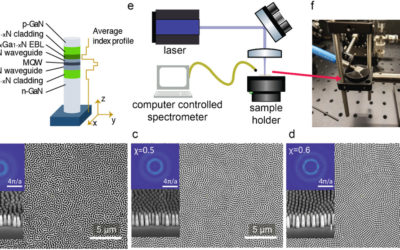
AI-driven, Robust, Flexible, Ultra-flat Optics
In the past 20 years, flat-optics has emerged as a promising light manipulation technology, surpassing bulk optics in performance, versatility, and miniaturization capabilities. As of today, however, this technology is yet to find widespread commercial applications....
Artificial intelligent designed ultra-flat optics with 99% experimental efficiency
Integrating conventional optics into compact nanostructured surfaces is the goal of flat optics. Despite the enormous progress in this technology, there are still critical challenges for real-world applications due to the limited operational efficiency in the visible...
NIST Certified cryptographic keys via deep-learning of aerogel PUFs
Physical unclonable functions (PUFs) are complex physical objects that aim at overcoming the vulnerabilities of traditional cryptographic keys, promising a robust class of security primitives for different applications. Optical PUFs present advantages over traditional...
Ultrafast AI photonics chip
An integrated, ultrafast, optical neuromorphic processor that: Realises an arbitrary Turing machine that can represent any arbitrary defined function of a multidimensional space of coordinates varying with time. It has the same expressive power of state of the art...
On-chip hyperuniform nanolasers
Designing light sources with controllable properties at the nanoscale is a main goal in research in photonics. Harnessing disorder opens many opportunities for reducing the footprints of laser devices, enabling physical phenomena and functionalities that are not...
Anapole invisible lasers for on-chip ultrafast pulse generation
Nanophotonics is a rapidly developing field of research with many suggestions for a design of nanoantennas, sensors and miniature metadevices. Despite many proposals for passive nanophotonic devices, the efficient coupling of light to nanoscale optical structures...
Dicke Phase Transition with Superradiant States
Superradiance—a cooperative phenomenon originally predicted by Dicke in 1954 for two-level atoms—consists of ubiquitous collective dynamics. Such an effect has been observed in a huge number of systems, both quantum and classical. Despite a large body of theoretical...
Energy equipartition and unidirectional emission in a spaser nanolaser
A spaser is a nanoplasmonic counterpart of a laser, with photons replaced by surface plasmon polaritons and a resonant cavity replaced by a metallic nanostructure supporting localized plasmonic modes. By combining analytical results and first‐principle numerical...
Ultrafast all‐optical order‐to‐chaos transition in silicon photonic crystal chips
The interaction of light with nanostructured materials provides exciting new opportunities for investigating classical wave analogies of quantum phenomena. A topic of particular interest forms the interplay between wave physics and chaos in systems where a small...
Fundamental and high-order anapoles in all-dielectric metamaterials via Fano–Feshbach modes competition
One of the most fascinating possibilities enabled by metamaterials is the strong reduction of the electromagnetic scattering from nanostructures. In dielectric nanoparticles, the formation of a minimal scattering state at specific wavelengths is associated with the...











Recent Comments